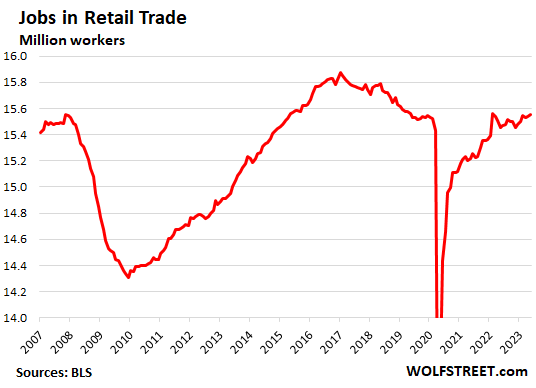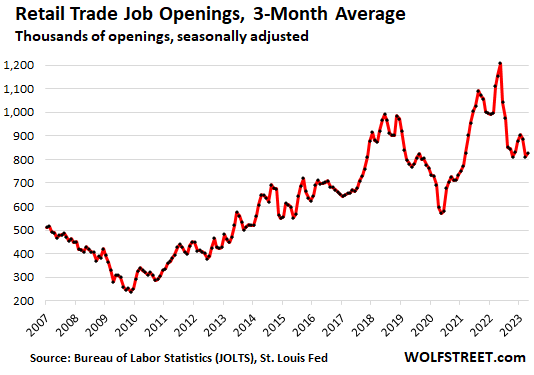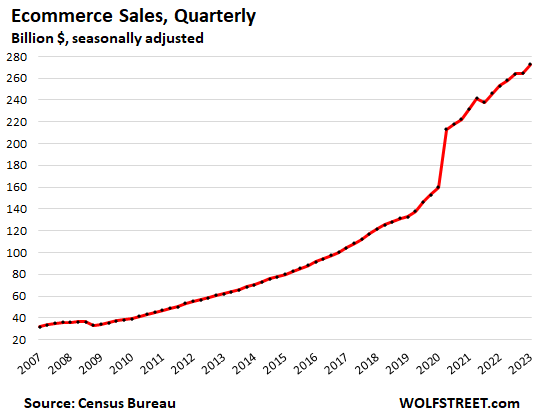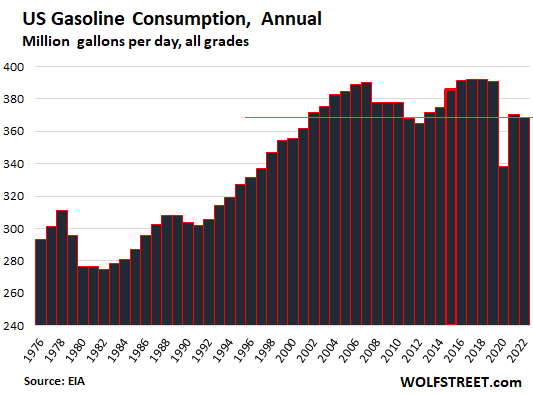Why Jobs in Retail Are at 2007 Levels: It’s Structural. Jobs in Ecommerce & Services Boomed but Aren’t in “Retail Trade.” And Half of Retail Trade is Moribund
Walmart U.S. gave us some color: ecommerce sales +27%; grocery sales +12%; non-grocery brick-and-mortar sales -10%.
By Wolf Richter for WOLF STREET.
The question that came up after my detailed report on jobs by employer category was this: Why were jobs in the “retail trade” in May, at 15.55 million, still down from the peak in 2016? And why were they about level with where they’d been at the end of 2007 before the Great Recession, even as total jobs at all “establishments” have grown by about 13% since 2007 and by 8% since 2016? Turns out, jobs in the “retail trade” are on a structural decline, despite surging retail sales, in part because of the way jobs in the “retail trade” are defined.

Jobs in the employment report are categorized by the NAICS (North American Industry Classification System) code of the location of the business where those jobs are.
Jobs in the retail trade include workers at brick-and-mortar retail stores and other retail locations. It does not include jobs in office buildings of ecommerce operations, such as tech workers or customer service workers; and it does not include drivers and warehouse employees, who are in their own respective categories based on location. The retail trade also doesn’t include restaurants; they’re part of Leisure & Hospitality.
And it’s not like the retail trade has a huge number of job openings it cannot fill (unlike some other sectors where labor shortages persist). Job openings at retail trade locations are now about where they’d been in 2018 and 2019:

What’s happening to jobs in the retail trade?
Walmart explained part of the phenomenon in its last earnings report. Walmart U.S. ecommerce sales jumped by 27% in Q1 year-over-year; grocery sales jumped by 12%; but sales except groceries at its brick-and-mortar stores fell by 10%. And so overall sales at Walmart U.S. rose by 7%, on booming ecommerce, strong grocery sales, and dropping sales at the other aisles in its stores.
Walmart is the largest grocery chain in the US and the second largest ecommerce retailer behind Amazon. Walmart figured out some years ago that it wants to survive, and it went where the sales are: ecommerce and groceries.
| Walmart U.S. | Q1 2023, Billion $ | Q1 2022, Billion $ | % change |
| Total sales | 103.9 | 96.9 | 7% |
| Grocery sales | 63.4 | 56.8 | 12% |
| Ecommerce sales | 14.5 | 11.4 | 27% |
| Non-grocery brick-and-mortar sales | 26.0 | 28.7 | -10% |
Ecommerce is booming, but its jobs are not in the “Retail Trade.”
Ecommerce sales hit $1.1 trillion in the past four quarters. And employment has boomed. But jobs in ecommerce operations are not jobs in the “retail trade.” Jobs in office buildings, warehouses, and delivery operations are not jobs in the retail trade. Retail trade jobs are those at brick-and-mortar retail locations.
So the employees working at a Walmart store are retail jobs. The employees working at a Walmart fulfillment center are warehouse jobs, Walmart drivers are in the category of drivers. Walmart’s tech jobs in an office building are in one of the NAICS categories that tech jobs fall into.

50% of retail sales are largely protected from ecommerce:
About 50% of retail sales (excluding food services such as restaurants) are in these three huge categories that have been mostly protected from ecommerce:
- New and used vehicle and parts dealers (largest retailer category).
- Food and beverage stores
- Gasoline stations
But even…
Gas stations are now seeing a persistent decline in demand for gasoline. Many of them have become convenience stores. The decline in demand is now being accelerated by the large-scale sales of EVs. Gasoline consumption in millions of gallons per day is below where it had been in the year 2002:

Some used-vehicle sales have wandered off to ecommerce, and all major used-vehicle dealers engage in ecommerce. But new-vehicle dealers are protected from ecommerce intruders by state franchise laws. You cannot buy a new vehicle from the automakers, you have to buy from a dealer. Dealers have websites. But the dealership does the deal. The exception is Tesla, which was granted exemptions in many states back when it was a nothing and no one took EVs seriously.
Some grocery sales have wandered off to ecommerce, but so far, Americans largely stick to going to the supermarket to buy food.
The other 50% of retail sales…
They’re exposed to the brutal force of ecommerce. But they’re hanging in there for as long as they can. Tens of thousands of stores have closed since 2017, when I started tracking this phenomenon under the category of “Brick-and-Mortar Meltdown.” In terms of Commercial Real Estate debt, retail is by far the worst, and has been for years, with huge default rates year-after-year.
Countless major retail chains have filed for bankruptcy and have been liquidated. Zombie malls are everywhere. Zombie malls in good locations are being bulldozed and redeveloped as housing. Even non-zombie malls are being redeveloped as residential or partially residential, such as Stonestown Galleria in San Francisco which is being redeveloped as mixed-use, with over 3,000 housing units, plus some retail.
And jobs don’t instantly vanish when a retailer files for bankruptcy. Bed Bath & Beyond, which filed for bankruptcy in April, is liquidating, and they now have their liquidation sales, and those employees are still counted as jobs in the retail trade.
Sears Holdings collapsed in slow motion and finally filed for bankruptcy in 2018. There are still something like 15 decrepit Sears stores around somewhere, out of 3,500 stores that Sears Holdings operated, and workers at those 15 stores still count as jobs in the retail trade. JC Penney got bought out of bankruptcy by giant mall landlords Simon Properties and Brookfield to keep the stores that anchor their malls from getting shut down. Many of its other stores were shut down. There are only a handful of department-store chains left, and they’ve all been aggressively shrinking their store count, and their jobs in the retail trade, from Macy’s on down.
All along the way, those retail jobs vanished in increments. It’s a slow process, it’s been going on for years, and it will continue to go on for years, I’ve been talking about it since 2017.
At the same time, supermarkets are thriving; some specialty stores are popping up, such as cannabis stores; and some new chains of small specialty stores, funded by investors, give it a go. And they all add some jobs to the “retail trade.”
Jobs in services grew – but they are not in the “retail trade.”
Services that are sold at brick-and-mortar store locations include food services (restaurants, delis, cafes), personal services (barbers, hair salons, nail salons, etc.); pet services, clinics, bank branches, etc. And they now tend to populate strip malls and outdoor malls – which are anchored by supermarkets, which are doing well too. And these types of service providers at street-level locations – from restaurants to bank branches or clinics – do well overall too. So that services-based arrangement is still working for landlords and is still generating jobs. But those jobs are not jobs in the “retail trade.”
Enjoy reading WOLF STREET and want to support it? You can donate. I appreciate it immensely. Click on the beer and iced-tea mug to find out how:

Would you like to be notified via email when WOLF STREET publishes a new article? Sign up here.
![]()
[ad_2]
Source link


